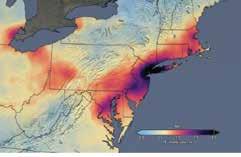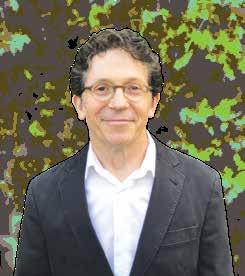
5 minute read
THE UPSIDE
THE UPSIDE OF LOCKDOWNS Air Gets Cleaner Around the Globe
by Kimberly B. Whittle
Around the world, the COVID-19 In China, as major cities shuttered pandemic has changed the way factories and reduced transportation earlier millions of people live their day-tothis year, experts found that carbon emissions day lives, but despite their dire consequences, dropped by about 100 million tons over a government-mandated lockdowns have two-week period. Scientists at the Royal had an unintended positive consequence: Belgian Institute for Space Aeronomy, in cleaner air. Brussels, are using satellite measurements of air quality to estimate the changes in nitrogen dioxide (NO 2 )—a pollutant emitted into the air when fossil fuels are burned—over the major epicenters of the outbreak. Their research shows that NO 2 pollution over Chinese cities decreased by an average of 40 percent during the lockdown compared to the same period in 2019.
Across the United Kingdom, the reduction in traffic and industry similarly impacted the climate. Within the first six weeks of lockdowns, in London, Birmingham, Bristol and Cardiff, NO 2 and fine particulate pollutant levels dropped by a third to half, with large declines recorded in other cities. These are the two air pollutants that have the biggest health impacts on people, says James Lee, professor of atmospheric chemistry at the University of York and research fellow at the National Centre for Atmospheric Science.
The U.S. has been part of these trends, as well. In Los Angeles, known for its smog, the air quality index improved by about 20 percent during March. According to Yifang Zhu, a professor at the University of California (UC) Los Angeles Fielding School of Public Health, during March, the region recorded the longest stretch of “good” air quality that it has experienced for 25 years.
NASA has observed significant air quality improvements in other parts of the U.S., as well. Satellite data for March showed that the mid-Atlantic and Northeast regions had the lowest monthly atmospheric levels of NO 2 that month since 2005. Data on NO 2 from the Aura Ozone Monitoring Instru
Thomas F Kabisch, DO, MDh – drkabisch.com –Awoon PLLC • Metro Ann Arbor • 734-971-5483 2350 E Stadium Blvd Suite 12
INTEGRATED GENERAL MEDICINE for the whole family.


46 years experience with guarantees –don’t waste money.

n Stem Cell Therapy n Complementary Cancer & Intravenous Therapy n Addiction Therapy n Age Management n ‘Simple Life’ Cancer
Prevention Program
n Homeopathy n Herbology n Nutriceuticals n Pharmaceuticals n Neuropsychology n Manual & Energetic
Medicines
Certified Health Education Courses See curriculum online, visit drkabisch.com now.
ment over the Northeast in March indicated that levels of the pollutant in March of this year were about 30 percent lower on average across the region of the I-95 corridor from Washington, D.C., to Boston than the mean of the previous five years.
Another immediate benefit of the reduction in pollutants is their effect on the pandemic itself. Public health experts agree people that have higher long-term exposure to fine particulate pollution have a 15 percent greater likelihood of dying from COVID-19. They attribute this to the lung damage caused over time by air pollution, combined with the fact that the virus targets the lungs and increases the risk of pneumonia.
Experts warn, however, that the cleaner air is likely to be temporary if we return to pre-COVID-19 levels of travel and industry. Although we have seen a dramatic reduction in greenhouse gas emissions, carbon dioxide (CO 2 ) levels—another important contributor to global warming—have continued to rise. “The crisis has slowed emissions, but not enough to show up perceptibly [in CO 2 levels everywhere]. What will matter much more is the trajectory we take coming out of this situation,” geochemist Ralph Keeling, who directs the Scripps Institution of Oceanography’s CO 2 monitoring program at UC San Diego, told TheWashington Post. But it’s possible that if people start expecting and demanding the cleaner air we have been enjoying during the pandemic, the coronavirus shutdowns could lead us to embrace new ways of living and working.
Jan. 1-20, 2020


Feb. 10-25, 2020
Stevens, J. NASA Earth Observatory (2020, January/February) Airborne Nitrogen Dioxide Plummets Over China
March 2015-19 Avg.


March 2020
Schindler, T. L. NASA’s Scientific Visualization Studio (2015-2020, March)
Scientists worldwide have emphasized that most of the air quality improvement is due to a reduction in traffic. Ed Avol, a professor of clinical preventive medicine at the University of Southern California, told Forbes that telecommuting is here to stay. “Telecommuting from home for those who can, even just for a couple of days a week, can have a marked reduction in terms of emissions.”
Kimberly B. Whittle is the founder and CEO of KnoWEwell.com, a community and marketplace platform committed to rigorous, evidenced-based research that empowers healthier living. To learn more, visit KnoWEwell.com or see ad on back cover.
Solutions for Pain AND A PATH TOWARD HEALTH & WELLNESS

Dr. Robert Krasnick has been performing regenerative procedures for over 20 years, including Prolotherapy, Platelet Rich Plasma, and Stem Cell Therapy.

In addition, Krasnick Regenerative Medicine is offering IV (intravenous) nutrient infusions, including Myers’ Cocktail, Glutathione, and NAD+. Also offered is UBI (Ultraviolet Blood Irradiation) combined with Ozone therapy. These treatments are designed to support your immune system, decrease inflammation and promote health and healing. If you have chronic pain and are looking for natural alternatives or interested in promoting your health, call today for a free consultation.
210 Little Lake Dr Ste. 8, Ann Arbor (734) 585-5653 • KrasnickRegen.com
“Prolotherapy a wise choice. I am completely healed, and good as new!” – Self-Verified Patient, 01/20/20







